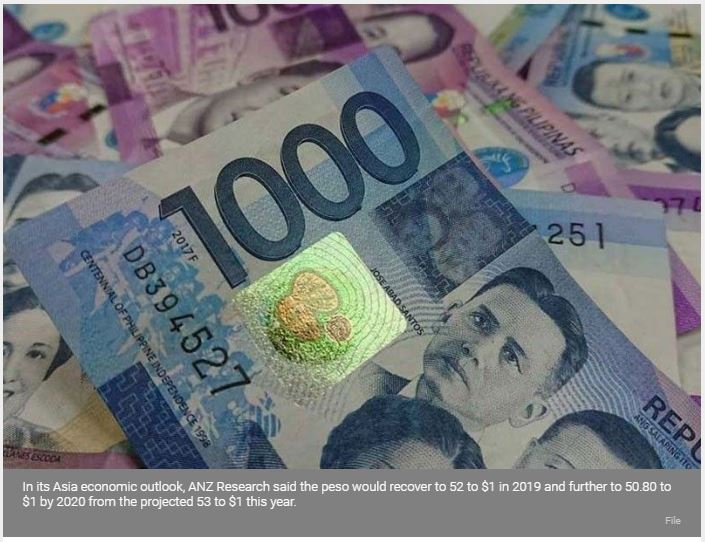Philippines: Investment banks see peso recovering in next 2 years
MANILA, Philippines — Some investment banks see the peso rebounding strongly over the next two years as higher interest rates and easing inflation would help attract foreign inflows and support the local currency.
In its Asia economic outlook, ANZ Research said the peso would recover to 52 to $1 in 2019 and further to 50.80 to $1 by 2020 from the projected 53 to $1 this year.
“The weakness in the peso in 2018 was mainly driven by domestic developments. High inflation after years of above potential growth, and a widening current account deficit were the main factors behind the depreciation,” ANZ said.
ANZ said easing inflation would help take some pressure off the currency.
However, it said the current account deficit would continue to be a source of vulnerability weighing on the peso as the shortfall has not shown any signs of improvement over the near-term.
“We are more constructive on the peso in the second half of next year, as tighter monetary policy starts to filter through to growth and inflation,” it added.
Inflation averaged 5.2 percent in the first 11 months of the year, exceeding the BSP’s two to four percent target, despite easing to a four-month low of six percent in November from a near-decade high of 6.7 percent in October, largely due to easing oil and food prices.
The Bangko Sentral ng Pilipinas (BSP) lifted interest rates five times by 175 basis points since May to curb rising inflation before taking a pause from its tightening episode by keeping rates steady last Dec. 13.
“This eventually should start to see a slowing in import growth, helping to narrow the current account deficit. Higher domestic interest rates and lower inflation will also help attract foreign inflows and help support the currency,” ANZ said.
Nomura Securities Ltd. is more bullish about the prospects of the peso against the greenback.
In its own Asia economic outlook, Nomura said the local currency would bounce back to 50 to $1 next year and further to 47 to $1 in 2020 from the projected 52.70 to $1 this year.
The Japanese firm said the peso would steadily appreciate to 52 in the first quarter, 51.50 in the second, 51 in the third, and finally to 50 in the fourth quarter.
The peso emerged as one of the worst performing currencies in the region, piercing the 54 to $1 level to hit its lowest level in 14 years due to the strong demand for US dollars to finance the importation of capital equipment, raw materials and intermediate goods to support the growing economy.
However, the local currency bounced back to the 52 to $1 level as inflation was seen easing back to the BSP’s two to four percent target.
Source: https://www.philstar.com/business/2018/12/26/1879837/investment-banks-see-peso-recovering-next-2-years#LgRwRj4APWHHXolg.99


 Thailand
Thailand




